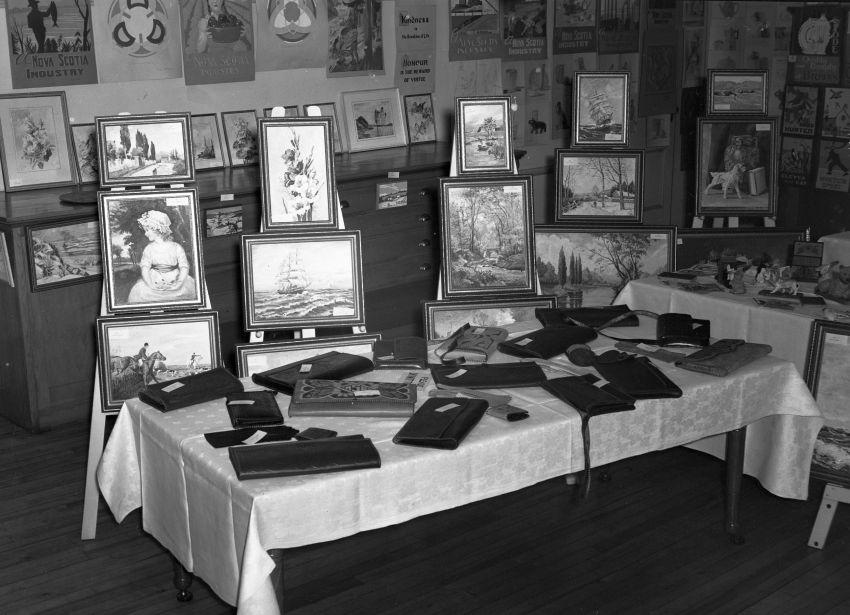It definitely wasn’t yesterday, but I vividly remember my mother guiding me through the door at the back of Holy Angels Convent and down the stairs to the gymnasium (a room larger than my six-year-old self had ever seen).
Grade two was just across from the gym, and down the corridor a few feet was Grade One, where I was welcomed by a small woman dressed almost completely in black, except for a white head covering, itself draped in a black veil—a sister of the Congregation of Notre Dame (CND).

Class at Holy Angels Convent circa 1945. (Photo by Abbass Studios via Beaton Institute)
During my 12 years at Holy Angels, I had only one lay teacher, all the rest being nuns, whose names I can still recite—Mothers St. Anna, Helen, Josepha, Mary Angela, Cuthbert, Rita, Aengus, Berthold, Mary Hector, Genevieve, Augustine, Peter, John Bosco, Daniel Marie, Mary Frederick and Seraphin. They provided me and my classmates with the basics of an excellent education while enriching our lives with religion, drama, music, art, public speaking and chorale singing.
It seems more than fitting that their convent will become a center of the arts for the CBRM as announced recently by New Dawn and the Nova Scotia Government, carrying on, in a very tangible way, the efforts and the dedication of the sisters of the CND.
Boarding-and-Day School
According to John Campbell’s history of Sacred Heart Parish, With Our Hearts and Hands, Sacred Heart pastor Fr. James Quinan talked for years about establishing a “boarding-and-day school for girls” as part of the parish. Parishioners and other benefactors were very supportive, donating funds and furnishings for the school. The building was completed and ready for the three CND sisters who traveled from Montreal to Antigonish, where they were met by Fr. Quinan who referred to them as “angels descended from heaven.” Sr. Domitilla, the Mother Superior; Sr. Helen of the Cross, the music teacher; and Sr. Mary Alexis, the French teacher arrived in Sydney on 7 November 1885 and began what would be 126 years of devotion to the education of young girls in the Sydney and surrounding area.

Teachers and students outside Holy Angels Convent circa 1885. (Photo via Beaton Institute)
The sisters also kept an accurate record of all matters pertaining to the school in the form of the “Annals,” written (in French for the first 36 years) and providing a wealth of information for future historians (including the fact that arsonists attempted not once, but twice, to burn the convent to the ground in 1887—the same year a devastating fire “set by the hand of a fanatic” destroyed Sacred Heart Church).
Nevertheless, by the end of that fateful year, “there were 15 boarders [who paid $2.00 per month] and a good number of externs” and two new teachers had been added to the staff, including a new music teacher. The sisters, who had purchased two pianos shortly after the school opened, proudly added a third, a testament to the number of students who desired to learn to play.
Concerts, during which music students displayed their skills, became a regular feature and monies received at the door helped to offset some of the expenses faced by the small school that continued to thrive, as indicated by a letter to the editor of the Sydney paper in 1890 noting that 22 licensed teachers had been produced “in only three years.”
Catechism & Comportment
Of course, the sisters of the CND had as their first vocation the teaching of the Catholic faith to their students, and they did so with a tremendous dedication, from preparing children for the sacraments—which included marching them over to Sacred Heart church for confessions every two weeks—to making sure they attended the children’s Mass on Sundays to teaching them the Ten Commandments, their prayers and the obligation to “know, love and serve God.” Eventually The Baltimore Catechism became the “go-to book” with all the answers, and students knew that for the first half-hour each morning they had better be prepared to answer whatever questions might be put to them by “the nuns.”

Art exhibit at Holy Angels Convent circa 1940 (Photo by Abbass Studios via Beaton Institute)
Just as important (well, almost as important) were the rules concerning deportment in the classrooms and corridors: no looking in any doors that happened to be open; no running either in the halls or on the stairs, no matter how late you might be; no chewing gum (do you think the Queen of England would chew gum in public?); when sitting down, assume your chair is where it should be, don’t turn to check. Religion was often an integral part of academic schooling, and one mantra still rings in the heads of many, “Use the brain God gave you.”
Students, at least in high school, were obliged to change their shoes in the “shoe room” before trekking upstairs to their classrooms. This was always done while one of the nuns watched to make sure their were no transgressors but, of course, the shoe-room shuffle was something most students attempted at one time or another, as they removed their outdoor shoes, shuffled them around and put them on again only to be called out by the watchful nun on the landing.
Expansion
By 1903, a second floor above the chapel had been built providing a “workroom and studio” which eventually became known as the “art room,” a further indication of the value the CND Sisters placed on all forms of artistic accomplishment. When, in 1905, 12 boarders had to be turned away, talk of expansion arose and once again, plans were made to raise money for an addition that required 8,000 cement blocks. The construction, which included a large auditorium, the setting for thousands of recitals, plays, pageants and graduations, became a reality in time for closing exercises in 1907 in which over 60 students participated.

Holy Angels Convent Choir circa 1940. (Photo by Abbass Studios via Beaton Institute)
As Holy Angels continued to grow, the arts remained an important feature of the life of the school, with St. Patrick’s and St. Andrew’s Day concerts, various plays, including Mary, Queen of Scots and The Merchant of Venice. Debating, which became a very important part of extracurricular activities at Holy Angels,was first mentioned in the Annals in 1927. In 1947, the rivalry between Holy Angels and Sydney Academy was on display in the convent auditorium, when Holy Angels won the “abolition of exams debate.”
By 1935, as the school celebrated its Golden Jubilee, the original group of three sisters from Montreal had grown to 28. The following year, half the student dormitory on the third floor was converted into two Grade 10 classrooms. That might have been when the so-called “golden stairs” from the third floor to the second were installed or renovated and quickly declared “out of bounds” to students, the ban being lifted only for such important events as graduations, when students came slowly and with great care down the stairs and into the auditorium where graduation exercises were held.
Look to the future
The arts flourished under the direction and cultivation of talented and dedicated nuns, including Sr. Rita Clare, now retired, who directed the Chorale beginning in the early ’70s. Choral music was given high priority, as was drama.
From the 1800s to the 1900s to the early years of this latest century, Holy Angels continued to provide students with a well-rounded education. Having started out with the basics of French, music and art, the sisters of the CND had, together with the many lay men and women who came on the scene at various times throughout the years, dedicated themselves to their students’ educational needs, ensuring that arts and culture were given equal footing with math, languages, history and sciences.
How fitting, then, that the original convent school, which became a true center for arts and culture, not just for the students themselves but for the entire community, should 126 years later be restored and renovated in order to accommodate today’s arts community.
New Dawn’s vision for the convent building as an “arts, culture and innovation centre, providing affordable space for artists, social enterprise and not-for-profit organizations” sounds like a project the CNDs past and present would view as a welcome and perhaps long-overdue project. To paraphrase Sister Eleanor Graham, Superior at Holy Angels during the 100th anniversary in 1985, New Dawn, together with the entire arts community, has an opportunity to “look to the future, risk the unknown and respond to the new and challenging with zeal and enthusiasm.”
Dolores Campbell, a lifelong resident of Sydney, is a freelance writer whose work has appeared in The Cape Breton Highlander, the Nova Scotian, Cape Breton Magazine, Catholic New Times and The Cape Breton Post.
The Cape Breton Spectator is entirely reader supported, consider subscribing today!









